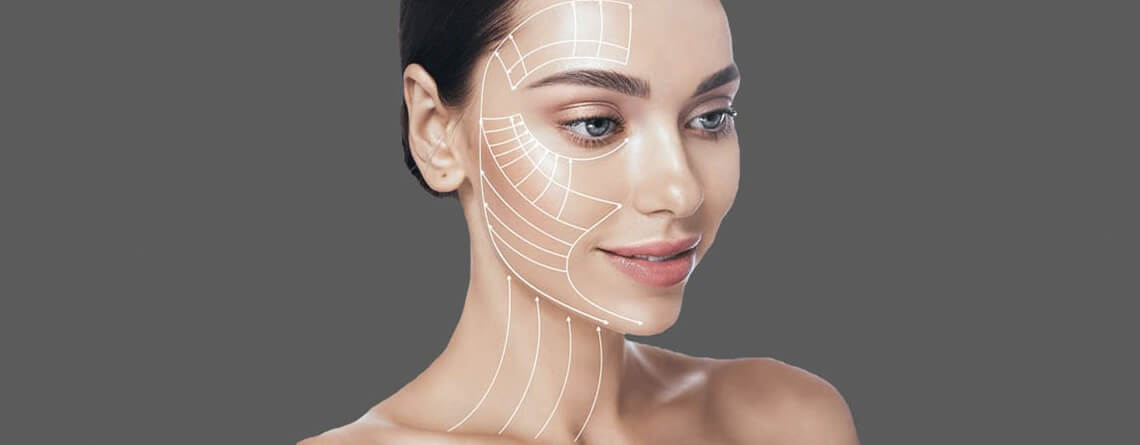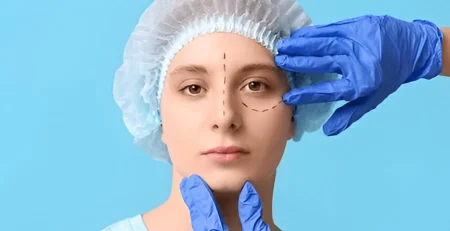Complete Guide to Facelift
As we gain years, the skin begins to lose its elasticity, and facial tissues start losing volume. The effects of ageing on the skin, include thinning and loss of muscle tone, “jowls” on the lower face, deep wrinkles, and loose skin on the neck, resulting in a sagging appearance of the face.
While some of this is a natural part of getting older, if these signs bother you, you may find a facelift surgery in India to be a good option. After a facelift, patients often notice an improvement in their self-confidence as their facial appearance accurately reflect their healthy, dynamic personality.
The demands of an attractive appearance and smooth skin are wanted worldwide. There are a lot of factors that influence the choice of rejuvenation techniques, including the anatomy of the facial skeleton, the severity of ageing changes, the social and economic status of the patient, and the structure of the skin.
What is facelift surgery?
A facelift (rhytidectomy) is cosmetic surgery to lift and pull back the skin to make the face tighter and smoother. The procedure is designed to reduce sagging skin around the lower half of the face and the neck. It eases the elimination of excess skin. The muscular tone and fat evaporate.
Facelift surgery in India is highly satisfying for most patients, as they tend to achieve a youthful appearance that lasts approximately 10 years.
A facelift improves the noticeable signs of ageing in the face and neck, such as:
- Relaxes the skin of the face that has been caused due to sagging
- Deepens the fold lines between the nose and corner of the mouth
- Improves fat that has fallen or has disappeared
- Developing of jowls in the cheeks and jaw
- Improves loose skin and excess fat of the neck that can show up as a double chin
Have questions or want to get started? We are ready to help you with a smile!
Symptoms and clinical evaluations for facelift
The best indication that you are in need of a facelift would be that you find the lack of stability of the epidermis and the greater variety of wrinkles around the face. This may be due to:
- Heredity
- Force of habit
- Pull of gravity
- Improper diet
- Exposure to the elements
Types of facelift surgery
If you’re considering undergoing a facelift, there are several types of facelifts that you should be aware of, including surgical and non-surgical. Depending on your needs for facial rejuvenation, one of the below facelift procedures by Dr. Rajat Gupta could help you achieve a more youthful appearance.
Traditional facelift surgery
Your surgeon will make an incision (cut) in the hairline from the temple, around and behind the ear, and back into the hairline. The skin will be lifted away from the underlying tissues. Muscles will be tightened, and fat will be discarded.Your surgeon will then pull the skin up and back towards the scalp, remove any excess then stitch or staple the skin into its desired position.
Mini Lift
A mini facelift is a part of facelift surgery. Before deciding the extent of incision, most operations use it as a starting point. It is frequently coupled with other facelift operations (such as the brow lift) for the greatest effects. Only the bottom-most part of the face is targeted during the treatment. The incisions are done from top to bottom along your ear’s natural curves, which keeps them completely hidden.
Neck lift
A surgery that improves the jawline and neck’s obvious indications of ageing is neck lift surgery. Your neck lift options include a typical neck lift incision or a minimal incision neck lift, depending on the degree of improvement you’d like to see. An incision often starts in the hairline at the sideburn region, proceeds down and around the ear, and finishes in the backside of the hair.
Things to take note of before deciding to have facelift surgery
Before you choose to undergo a facelift, some key issues to keep in mind include:
- A facelift will not lift sagging eyebrows, eliminate deep wrinkles in the forehead, modify your upper or lower eyelids, or reduce creases around the lips.
- Post surgical results are expected to last between 5 to 12 years.
- The normal ageing process will continue even after the surgery.
- Smokers are at an increased risk of mishaps. To lower the risk of complications and for your general health and wellbeing, try to quit smoking at least three weeks before the surgery.
Facelift – what to expect during surgery
Facelift surgery is usually performed under the influence of general anaesthetia. The length of the operation usually depends on the type and extent of the surgery but could take anywhere from two to four hours.
Anaesthesia
Medications are administered to you for your comfort during the surgical procedure. The choices at this stage include intravenous sedation and general anaesthesia. Your doctor will recommend the best possible choice for you. A variety of other procedures can further enhance the result of a facelift. They include:
- Facial implants or fat transfer to improve the contour
- Resurfacing techniques to enhance the tone and texture of facial skin
- Reduction of wrinkle by injection of fat or fillers
Incision
The surgery begins with an incision starting in the hairline near the temple, tracing a path in front of the ear, around the earlobe, behind the ear, and ending again in the posterior hairline. A small incision is made under the chin if a neck lift is also performed alongside. For men, the incision is made so as to accommodate natural beard lines. In a majority of cases, the incisions are placed where they will fall into a natural skin crease for camouflage.
Procedure
A skin flap is lifted over the tissues that will be elevated in surgery. A second tissue layer, deep into the skin, is then sutured. Tensioning of this layer gives way for tightening facial jowls and improving jawline contour. This tissue layer is subsequently suspended from the upper face and sutured roughly horizontally, allowing for tightening of the lower face and adjoining jawline. If neck tightening is also needed, an incision is made under the chin. The platysma muscle is exposed. The platysma muscle allows for rejuvenation of the neck, and also causes “neck bands.” The platysma is secured behind the ear to the mastoid bone for a more horizontal pull, using sutures that ultimately are absorbed. Excess skin leftover from these procedures is eventually discarded.
Closure
Once the surgeon is satisfied with the required “lift” and the extra skin has been trimmed, the skin is then closed with sutures. A mix of absorbable and permanent sutures is used. Staples may be used in the skin in the hairline, as this does not cause harm to the hair follicles. A face lift dressing is applied to put pressure on the incision lines and surgical area to keep the swelling at bay and lower the chance of fluid collection in the surgical wound.
Who is a good candidate for a facelift?
Facelift surgery is a highly customized procedure. You should only do it for yourself, not to fulfil someone else’s desires or to try to fit any sort of an ideal image.
Ideally, good candidates for a facelift include:
- Healthy individuals who do not have medical conditions that impair healing
- Nonsmokers
- Individuals with a positive outlook and realistic expectations
What should you expect during a consultation for a facelift?
During your facelift consultation with Dr Rajat, make sure to discuss:
- Post Surgical Goals
- Medical History
- Allergies due to durgs
- Ongoing medical treatment
- Any kind of substance abuse
- Previous surgical history
Your surgeon will also:
- Evaluate your general health status and any pre-existing health conditions or risk factors
- Discuss your facelift options
- Examine and measure your face
- Take photographs from different angles
- Recommend a course of treatment
- Discuss potential outcomes of a facelift and any risks or possibility of likely complications
It’s important to understand all the multiple aspects of your facelift surgery. It’s natural to be anxoious about it, whether it’s excitement for your anticipated new look or a bit of preoperative stress. Don’t think twice before discussing these feelings with your cosmetic surgeon. To help, we have prepared a checklist of questions to ask the facelift surgeon that you can consider taking along with you to your consultation.
Questions to prepare beforehand to ask your plastic surgeon about facelift surgery
Here’s a list of questions to ask during the consultation:
- Are you a board-certified plastic surgeon?
- Do you have the right tools to perform facelift surgery at your centre?
- Am I an ideal candidate for this procedure?
- What can I anticipate to get the desired results?
- Where and how the surgical procedure for a facelift will be performed?
- What surgical techniques and tools will be used for my surgery?
- What will be the recovery period? What am I supposed to do post-surgery to recover quickly?
- Are there any risks involved in face lift surgery?
- What to anticipate post-surgery for my face to look like?
What should you expect during your facelift recovery?
Following a facelift procedure, a bandage might be placed around your face to minimize the effect of swelling and bruising. Small tubes may be required to be put in place to draw off any excess blood or fluid.
You will be given certain necessary instructions on how to care for the surgical site, which medications to apply topically or taken orally and when to follow up with your plastic surgeon.
As an individual, you will likely experience a certain level of bruising and pain. You may have swelling all over the face for some time. You can use a cold compress to help abate the swelling. While bending down, make sure to keep your face in an elevated posture. You need to stop hard labour for about two to three weeks following the operation.
How should you prepare for a facelift?
In the time leading upto the facelift, you may be asked to:
- Get lab testing or a medical check up done
- Take certain medications or adjust your current medications as per the need
- Apply certain products to the facial skin preoperatively
- Quit smoking temporarily
- Avoid the consumption of aspirin, anti-inflammatory drugs, or herbal supplements as they can increase bleeding and subsequent bruising
Your surgeon can do a facelift in a hospital or an approved surgical centre. You must plan for a friend or family member to drive you home after surgery and to remain with you for the first night.
What results should you expect after a facelift?
While most people are presentable to the public within 10-14 days, it will take 2-3 months for the face to feel “back to normal” in terms of texture, sensibility and loss of tightness.
Continuing daily sun protection and a healthy lifestyle will help extend your facelift. As swelling and bruising subside over the weeks, the visible improvements of a facelift start appearing. Your final outcome should provide a more youthful and pronounced appearance. Follow your doctor’s instructions to ensure success.
Facelift surgery cost in India
Depending upon the extent of loose skin, deep line, and sagginess, the expert cosmetic surgeon will propose the best-suited facelift surgery procedure that is sure to bring about your youthfulness and best features.
India offers exceptional quality cosmetic surgery that is at par with the international standard quality of procedures. The cost of facelift surgery in India is considered to be only a fraction of what it would cost to undergo the same procedure in countries like the US, UK, Singapore, etc. The affordability of facelift surgery and the expertise of cosmetic surgeons make India an attractive option.
Why trust Dr Rajat Gupta with your facelift surgery?
Dr Rajat Gupta is a board-certified plastic surgeon and one of the most extensively trained cosmetic surgeons. He has 13+ years of experience in plastic surgery under his belt and has also led pioneering work in this field, which has put India on the world map when it comes to cosmetic surgery.
Having gained significant exposure to several countries during his training years, he came back to India to apply the same set of international standards to Indian procedures, and overtime has also led to pioneering work in this field within India. He adopts a curious approach in his treatment plans by having the patient take the lead to understand their goals better and provide life-changing results!
Dr. Rajat Gupta
MBBS, MS, DNB(Gen. Surg.),
DNB (Plastic Surgery)
Dr. Rajat Gupta is a board certified plastic surgeon in India with 13 years of experience to back his expertise in the domain of aesthetic surgeries.
Having completed his training from Maulana Azad Medical College and equipped with a thorough understanding of aesthetic needs of people, Dr. Gupta strives to offer the best remedies and cosmetic procedures outfitted with the latest technology to the aspirants in India and across the globe. To book an appointment, call: +91-9251711711 or email: contact@drrajatgupta.com













